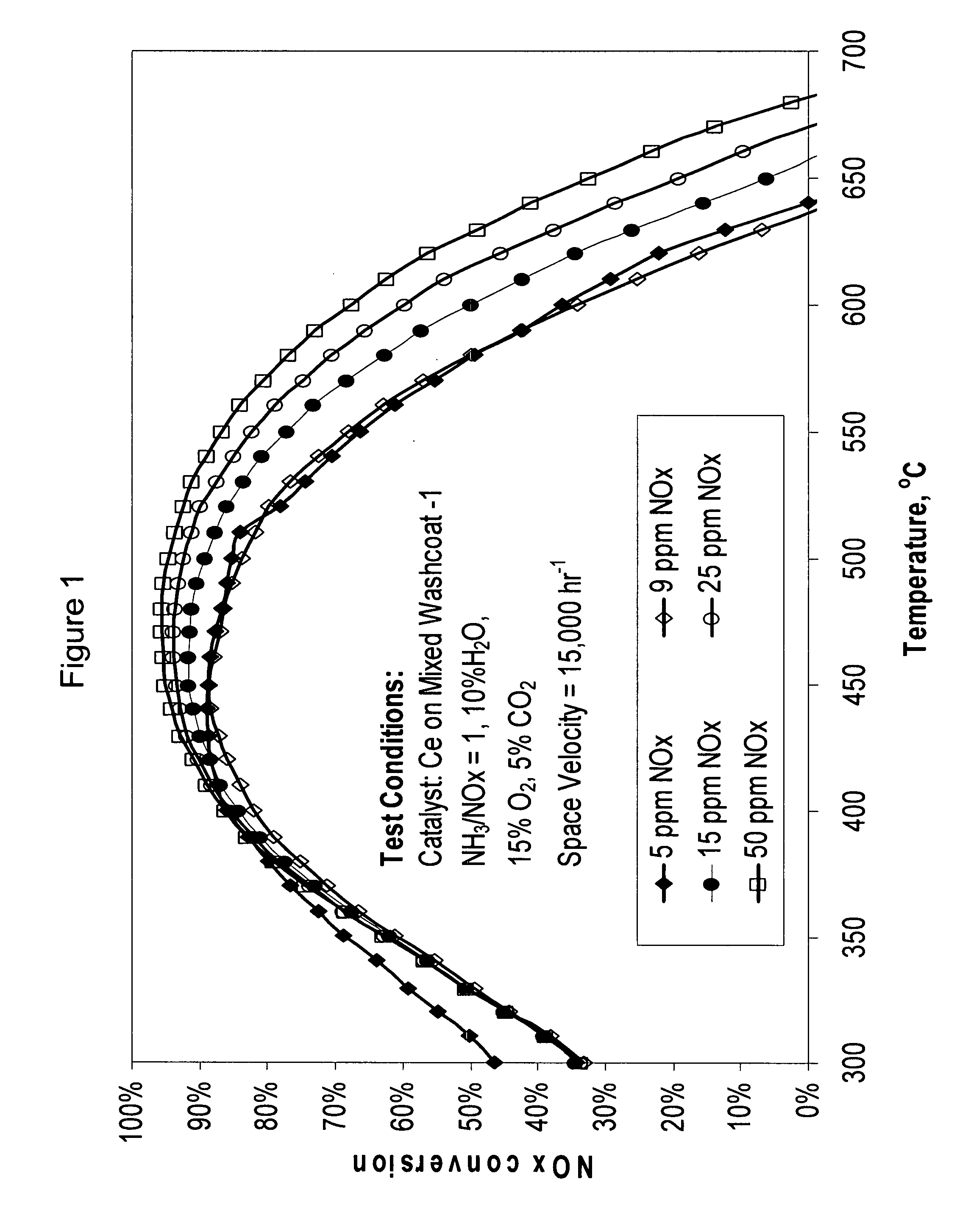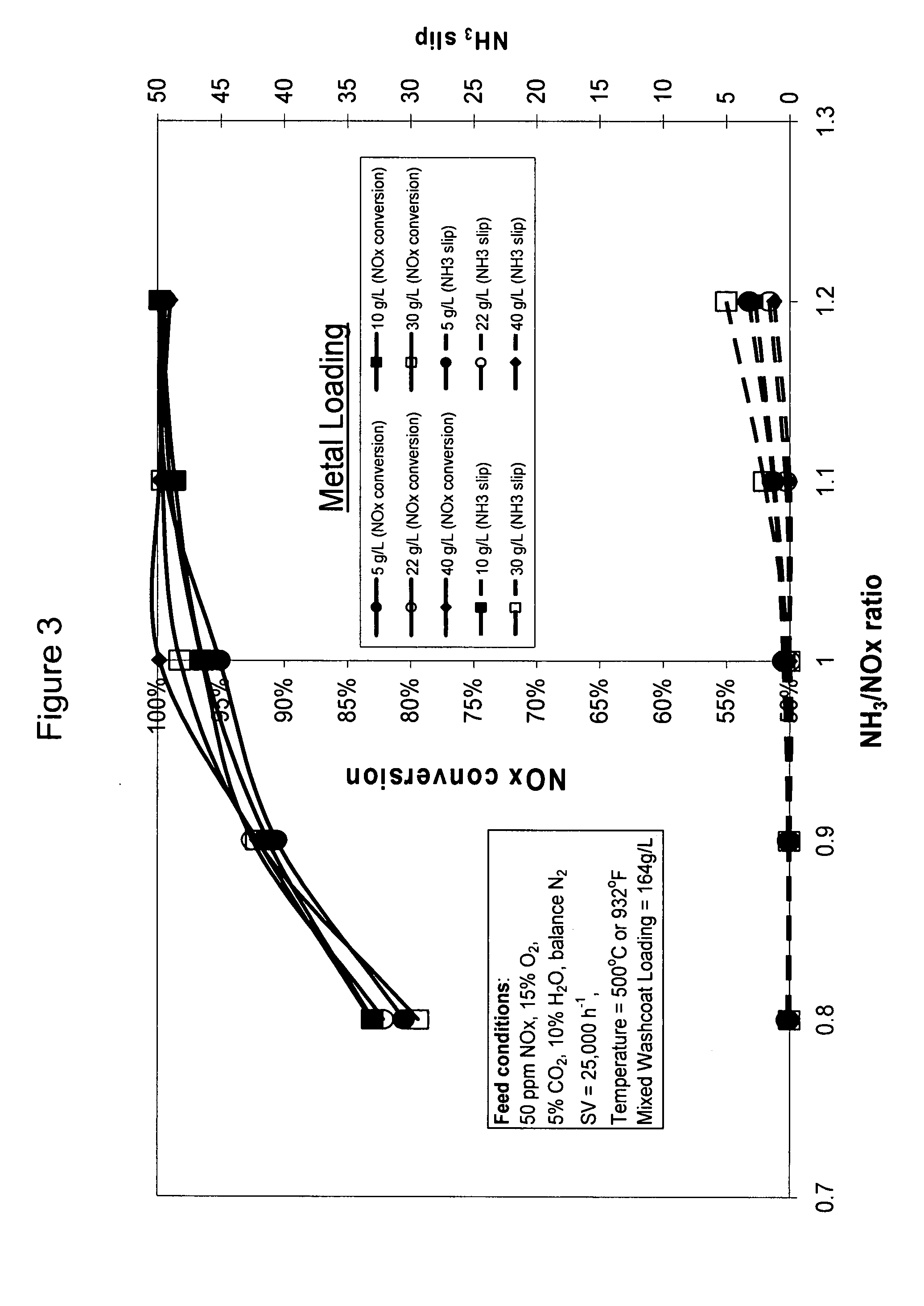High temperature ammonia SCR catalyst and method of using the catalyst
a technology of ammonia scr and catalyst, which is applied in the direction of catalyst regeneration/reactivation, physical/chemical process catalyst, catalyst for diesel applications, etc., can solve the problems of significant nitrogen oxide and particulates emissions from diesel-fueled vehicles, copper catalyst deactivation is significant when aged, and catalysts used with diesel applications are not likely to work effectively when used with gas turbines or gas engines, etc., to achieve selective reduction of nitrogen oxides
- Summary
- Abstract
- Description
- Claims
- Application Information
AI Technical Summary
Benefits of technology
Problems solved by technology
Method used
Image
Examples
example 1
Preparation of Cerium Mixed Washcoat Catalyst
[0071]A cerium mixed washcoat catalyst (Catalyst 1) was prepared as follows. An aqueous slurry of mixed washcoat was formed. The mixed washcoat contained about 10% alumina, 50% mixed zeolites, and 40% Ce0.24Zr0.66La0.04Y0.06O2. The mixed zeolites were H-ZSM-5 and H-beta in a 50:50 weight ratio. All percentages are by weight unless otherwise indicated.
[0072]The slurry was ball milled to a particle size (d50) of about 4-5 μg. The slurry was placed on a 400 cells per square inch monolith substrate such that the wall passages of the monolith were coated with the washcoat at a loading of about 160 g / L. The coated monolith was placed under light to confirm that no channels were plugged by the mixed washcoat slurry. If there were any plugged or clogged channels, they were cleared by blowing air using an air-knife. The washcoated substrate was dried by blowing air through the open channels at room temperature for about 10 to 15 hours. The dried w...
example 2
Preparation of Cerium Mixed Washcoat Catalyst
[0077]A cerium mixed washcoat catalyst (Catalyst 2) was prepared as follows. An aqueous slurry of mixed washcoat containing cerium was formed. Powders of 10% alumina, 50% mixed zeolites, and 40% Ce0.24Zr0.66La0.04Y0.06O2 were mixed with a solution containing cerium nitrate and water. The mixed zeolites were H-ZSM-5 and H-beta in a 50:50 weight ratio. Sufficient cerium nitrate solution was used in order to result in 22 g / L cerium on the final catalyst.
[0078]The slurry was ball milled to a particle size (d50) of about 4-5 μl. The slurry was placed on a 400 cells per square inch monolith substrate such that the wall passages of the monolith were coated with the cerium containing mixed washcoat at a loading of about 160 g / L. The coated monolith was placed under light to confirm that no channels were plugged by the mixed washcoat slurry. If there were any plugged or clogged channels, they were cleared by blowing air using an air-knife. The cer...
example 3
Preparation of Mixed Washcoat Catalyst Containing No Cerium
[0080]A catalyst containing no cerium was prepared according to the procedure described in Example 2 except that no cerium nitrate solution was added to the powder mixture. The slurry was formed by mixing the powders described in Example 2 with water. The mixed washcoat loading on the final catalyst was about 160 g / L.
PUM
| Property | Measurement | Unit |
|---|---|---|
| exhaust temperatures | aaaaa | aaaaa |
| exhaust temperatures | aaaaa | aaaaa |
| weight percent | aaaaa | aaaaa |
Abstract
Description
Claims
Application Information
 Login to View More
Login to View More - R&D
- Intellectual Property
- Life Sciences
- Materials
- Tech Scout
- Unparalleled Data Quality
- Higher Quality Content
- 60% Fewer Hallucinations
Browse by: Latest US Patents, China's latest patents, Technical Efficacy Thesaurus, Application Domain, Technology Topic, Popular Technical Reports.
© 2025 PatSnap. All rights reserved.Legal|Privacy policy|Modern Slavery Act Transparency Statement|Sitemap|About US| Contact US: help@patsnap.com



